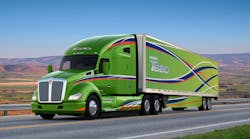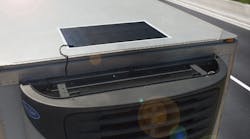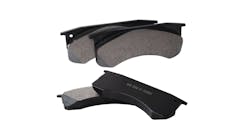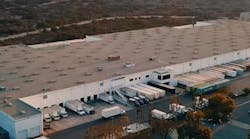[ H: ] Ways to go “green”
More and more truck fleets are working to address energy and resource consumption in their operations. They are establishing sustainability goals and reducing their carbon footprint.
A portion of this effort is devoted to adopting “green technologies” to increase the efficiency of their trucks while reducing engine emissions and lowering operating costs, of which fuel is one of the biggest expenses.
These technologies run the gamut. This article is a roundup of just a few of the ways to help green a heavy duty truck fleet.
= = =
[ H: ] Part 1: It’s all about inflation
[ D:] Tire pressure monitoring systems can help
[ byline ] By Mike Roeth, Executive Director, North American Council for Freight Efficiency (NACFE)
You can put the most fuel-efficient tires on your trucks, but if you fail to keep them properly inflated your fuel economy gains will roll away.
In conducting its Confidence Report on Tire Inflation Systems, NACFE found that underinflation causes a 0.5 to 1.0 percent increase in fuel consumption for a vehicle running with its tires underinflated by 10 psi.
In addition, underinflated tires wear faster and have tire degradation of as much as 5 to 12 percent on a tire that is underinflated by 10 psi.
Underinflated tires aren’t going to help you achieve your goal of being greener.
DRIVERS AND TIRES
In theory, drivers are supposed to be checking inflation pressure during their pre-trip inspections, but the NACFE study team learned that for most fleets, that was not working. Industry statistics showed that:
- About one out of five trucks is operating with one or more tires underinflated by at least 20 psi.
- One in five trailers is operating with one or more tires underinflated by at least 20 psi.
- Nearly 3.5 percent of all trucks operate with four or more tires underinflated by at least 20 percent.
- Only 46 percent of all tractor tires and 38 percent of all trailer tires inspected for a Federal Motor Carrier Safety Administration report were within ±5 psi of the target pressure.
TIRE SYSTEMS
Fortunately, there are things that can be done to augment what your drivers are doing and ensure your trucks’ tires are at their proper inflation levels.
Tire pressure monitoring systems (TPMS) are designed to provide a direct measurement of pressure, and in some cases, temperature. Inflation pressure is measured against preset targets, and when the inflation pressure falls before the acceptable level, the driver is alerted via a visual display at the wheel end or, in more sophisticated systems, by an in-cab display.
Another option is automatic tire inflation systems (ATIS). These systems not only monitor inflation pressure against a preset target, but also re-inflate tires when detected pressure is below the target level. In general, these systems alert the driver that re-inflation is occurring, but they do not report on the actual pressure in the tire.
Either type of system will work for a fleet, but the study team found that for-hire trucking companies tended to adopt tire inflation systems, whereas their private fleet counterparts prefer tire inflation monitoring systems.
Regardless of fleet type, the fleet owners the NACFE study team spoke with said their choice of system was contingent on their drivers. For-hire fleets tend to more highly value systems that did not require interaction from the driver, while private carriers wanted to better engage their drivers in fixing the inflation problem so opted for tire pressure monitoring systems.
FLEET EXPERIENCES
Some real world examples from the Confidence Report show the benefits of tire monitoring systems.
A large truckload carrier with 5,000 tractors and 15,000 trailers with tractors averaging 124,000 miles per year elected to install ATIS on all new trailer purchases beginning in 2012, and to retrofit the system on their trailers that were nine years old or newer. The fleet conducted its own fuel efficiency comparison tests and found a 1.5 percent mile per gallon improvement on the trucks equipped with ATIS.
The same fleet has decided to focus on drivers manually checking inflation pressures on tractor tires and expanded its training efforts to ensure drivers knew the proper way to check tire inflation.
In another example, a private fleet retrofitted TPMS on most existing trailers beginning in 2007, currently specifies TPMS on all new trailers and, since 2011, has purchased TPMS on all new tractors. The fleet saw a fuel economy improvement of 0.75 percent on tractors and a 1.25 percent improvement on trailers equipped with TPMS.
IMPROVED
The reliability and durability of the available commercial vehicle tire pressure systems is strong. Problems with early models have been corrected and current products are performing well.
The NACFE study team concluded fleets should have confidence in adopting tire pressure systems. However, they said fleets should investigate and test the system that best fit with their goals, will meet their operational needs and help them achieve their green goals as well.
Mike Roeth is executive director of the North American Council for Freight Efficiency (NACFE), an organization created to drive the development and adoption of efficiency-enhancing, environmentally-beneficial and cost-effective technologies, services and methodologies in the North American freight industry by establishing and communicating credible and performance-based benefits. nacfe.org.
= = =
[ H: ] Part 2: Vehicle power consumption reduction by lowering aerodynamic drag
[ D: ] How boat tails and trailer skirts can help
[ Byline ] By David A. Kolman, Editor
When it comes to aerodynamics, a large, rectangular box is just about the worst possible shape to pull down the highway, observes Bob Montgomery, vice president of innovative tire and mileage solutions, for Stemco. At highways speeds, 65 percent of the fuel consumed by a tractor trailer is directly related to aerodynamic drag, most of which occurs at the front of the tractor cab, in the gap between the truck and the trailer and underneath and behind the trailer.
Stemco (www.stemco.com) is involved in the technology and manufacture of commercial vehicle wheel end, braking and suspension components. In February, it acquired ATDynamics, a transportation technology company and a supplier of semitrailer rear-drag aerodynamics technology.
A modern solution to reducing aerodynamic drag – and therefore emissions, fuel consumption and equipment wear – is the installation of a boat tail, also known as a rear tail fairing, and side skirts, also referred to as trailer skirts, he says.
“A boat tail increases fuel efficiency by significantly reducing the aerodynamic drag behind the trailer, which typically causes a low-pressure vacuum that pulls backward on the vehicle and creates turbulent airflow,” he explains. “The skirts reduce the aerodynamic drag below the trailer, where air curls in and hits the trailer’s rear axles.”
Each aerodynamic device can be installed in about one hour by two installers on both new and existing trailers.
ROI
Investing in a boat tail and side skirt can pay off quickly, says Montgomery.
“Fleets see an average return on investment in about a year after installing the equipment. Boat tails and trailer skirts used together can reduce fleet fuel consumption by approximately 16 gallons of diesel fuel for every 1,000 miles the trailer is pulled.”
Stemco’s combination of the TrailerTail and EcoSkirt, for example, meets the U.S. EPA’s new SmartWay Elite category by delivering verified fuel savings of more than 9 percent. The TrailerTail alone is SmartWay verified and meets the CARB emission requirements by delivering verified fuel savings of more than 5 percent.
The benefits stretch far beyond fuel savings. With improved efficiency comes reduced emissions.
“Long-haul semi-trailers equipped with both a boat tail and trailer skirt offset the approximate carbon emissions of two passenger vehicles per year,” Montgomery notes.
VEHICLE HANDLING
Reducing the aerodynamic drag reduces air turbulence, which makes the trailer easier to handle for the driver. It also improves stability in windy conditions and increases visibility in wet weather, for both the driver and following vehicles.
“Fleet owners who installed both side skirts and boat tails reported reduced driver exhaustion, an improved driver experience and increased road safety for drivers and the public,” says Montgomery. “Reduced trailer sway also lowers operating costs by reducing wear and tear on tires, one of the single biggest ongoing maintenance expenses for any trucking operation.
“Installing a boat tail at the rear and a skirt under a tractor trailer is a fast and affordable way to reduce fuel consumption and carbon emissions for commercial fleets,” he continues. “Together, these technologies significantly improve fuel efficiency, reduce carbon emissions and lower operating costs to create a win/win scenario for the trucking company and the environment.”
= = =
[ H: ] Part 3: Retreading offers performance and environmental benefits
[ D: ] Why it makes sense to use retreads
[ byline ] By David A. Kolman, Editor
Each year, millions of commercial truck tires wear out. A significant percentage of those tires will “live on” as retreads – enabling fleets to optimize their tire investment and prevent numerous casings from entering landfills.
“Retreads can be an excellent alternative to new truck tires, especially for fleets that are keeping a close tab on expenses,” says Brian Buckham, general manager, product marketing, Goodyear Commercial Tire Systems (www.goodyeartrucktires.com), which offers a total package solution of tires, services and profitability tools to help commercial trucking fleets lower their total cost of ownership.
ADVANCES
“Today’s retreads are more technologically advanced than ever, delivering miles to removal that were previously unattainable,” Buckham points out.
“Forty years ago, retreads would wear out after 60,000 or 70,000 miles. Now, it’s possible for a premium retreaded tire – particularly one that contains Goodyear retreading technology – to go 200,000 miles or more, depending on wheel position and maintenance.”
LESS OIL
The benefits of retreading to the environment can be significant, as well.
According to the Tire Retread & Repair Information Bureau (TRIB), it takes 22 gallons of oil to produce a new truck tire, but only seven gallons to retread an existing truck tire casing. “Every year in North America, the use of retreads saves hundreds of millions of gallons of oil,” say TRIB officials.
TRIB (www.retread.org) is a nonprofit tire industry association dedicated to the promotion of tire recycling through retreading and repairing.
In addition, many treads, such as those made with Goodyear’s spliceless UniCircle Technology, are optimized to deliver enhanced fuel efficiency, says Goodyear’s Buckham.
Goodyear, like some other tire companies, offers retread products that have earned EPA SmartWay verification. These are technologies that provide fuel saving and/or emission reduction benefits when used properly in their designed applications.
HOW TO FIND A RETREADER
Quality retreaders produce quality retreads, Buckham says, and offers these tips to help fleets select a high-quality retread supplier:
1. Check reputation and references. Select a retreader that has a solid reputation. Ask the retreader for customers’ names and call them for references.
2. Interview sales reps. Are the retreader’s salespeople knowledgeable? Do they provide straightforward answers to questions about turnaround time, pricing and other subjects?
3. Visit the plant. Will the retread plant manager show you the facility? Does the facility – including the service department and warehouse – look good?
The basic elements of retreading – time, temperature and pressure – have not changed over the years, he notes. However, tread rubber production and the tread application process have improved. The plant being assessed should reflect this.
4. Evaluate. What is the retreader’s turnaround time? “No more than seven days is acceptable,” says Buckham. Does the company offer a mounted wheel program? Is the retreader part of a larger network, such as the Goodyear Commercial Tire & Service Network, that can offer emergency roadside assistance, consistent pricing for national account customers, consistent service standards across locations and other advantages?
5. Check the condition of the retreads. Do they look new? Ask about rejection rates. The retreader should be willing to share this information.
6. Examine your options. Does the retreader offer a variety of retread processes? How many different treads are available? Will you have a diverse menu of options?
7. Look for IT (information technology). Does the retread facility track information about casings? Does the customer have access to this information? Is there a system in place that can aggregate data into easy-to-access reports so you can make better-informed decisions?
= = =
[ H: ] Part 4: Harness the power of sunshine to maintain vehicle battery systems
[ D: ] The use of solar panels for battery maintenance
[ byline ] By David A. Kolman, Editor
The installation of solar panels for regular and routine battery maintenance can be a solution for commercial vehicles. However, say officials with PulseTech Products, it is important to:
- Choose the right solar panel for the amount of power needed, along with the size and place of the mounting location.
- Select solar products that have the capability to desulfate and maintain all types of vehicles with 12V and 24V lead acid battery systems, including conventional flooded, AGM and VRLA types.
PulseTech (www.pulsetech.net) develops and manufactures next-generation battery testing, maintenance and charging systems.
The officials recommend a solar system utilizing higher efficiency, higher quality crystalline silicon cells that pack more power per square inch than standard amorphous “thin film” solar cells. Typically “crystalline” solar cells have a footprint that is 50 percent smaller than the amorphous cells that are commonly used.
Today’s solar products can be found for any 12V or 24V battery and typically come in 2-, 5-, 6- and 25-watt versions. The better systems, note the officials, are “protected with a clear, polyurethane plastic coating mounted on a laminated aluminum substrate to make them virtually indestructible and impervious to weather, aging and damage from bumps and knocks.”
BENEFITS
As an example of the benefits of a solar maintenance system, PulseTech officials say a top supplier of ready mixed concrete, sand and gravel, asphalt and construction services instituted a battery management program, along with the installation of a compact PulseTech SP-5 (5-watts of power) solar battery charger maintainer. That company’s fleet readings, after six months use, showed that Cold Cranking Amps (CCAs) on all trucks were improved by 32 percent, bringing the batteries’ performance back to optimum levels.
In another case, a major bottling company had been suffering from severe battery-related problems with its delivery fleet and pallet jacks. Commercial 12V solar panel battery maintenance systems were installed on the trucks, as well as a 24V maintenance system on one of the pallet jacks to desulfate two-year-old batteries that were set to be replaced.
“The maintenance systems offset the parasitic drain and removed enough sulfation buildup to increase the condition of the batteries, and as a result, CCAs on all the truck batteries was up, providing an easier start,” say the PulseTech officials. “The pallet jack usage time was also greatly extended between battery recharges, plus the clean battery once again accepted a full charge allowing for a full eight-hour shift usage.”
SULFATE BUILD-UP
As a battery ages through use or sits unused for periods of time, lead sulfate crystals can enlarge and build-up excessively to the point where they create a physical barrier across the surface of the battery plates, explain PulseTech officials. Before long, this build-up can become so dense that a battery is no longer able to accept or release energy.
The company’s “exclusive Pulse Technology cleans (desulfates) the plates and brings the battery to a like-new state capable of holding a full charge,” they say. The technology has been proven “to extend 12V lead acid battery life up to three to five is typical.
“Not only does poorly or inefficiently managed battery maintenance lead to early failure and unnecessary replacement costs, but can also lead to ‘emergency’ and expensive jump starts and that takes away from the vehicle’s daily schedule and ability to perform.”
Downtime is money lost and premature battery replacements, and that, especially for commercial fleets, is a budget breaker.
= = =
[ H: ] Part 5: How reusable shop towels contribute to a greener fleet
[ D: ] Reusables use less energy and reduce solid waste
[ byline ] By David A. Kolman, Editor
In recent years, entire businesses have been built around the concept of selling products, seminars or training to help make a fleet or shop more environmentally friendly. One impactful way to green a fleet or shop is also the most simple, and it starts with an elemental tool of any fleet: shop towels.
Selecting reusable shop towels rather than disposable shop towels offer a number of benefits, says Joseph Ricci, president and chief executive officer of TRSA (www.trsa.org), an international organization representing companies that supply reusable laundered garments, uniforms, linens, mats, towels and other products necessary for businesses to operate safe, clean facilities and provide a clean, attractive environment and image. Among them:
1. Save Money. A single reusable shop towel can handle 10 light-soil wiping tasks or two very heavy wiping tasks, compared to one disposable, “saving anywhere from 83 to 15 percent, respectively, on related costs, says Ricci.
2. Less Energy. Both reusables and disposables consume the most energy in their genesis: acquiring raw materials for their manufacturing. But disposable wipes use more energy once manufacturing begins.
“Overall energy usage for reusables is just 10 percent of the requirement for nonwoven and paper towels,” Ricci says, “even though cloth towels are shipped back and forth to textile services plants for laundering.”
3. Improved Air Quality. Substituting reusable shop towels for 10 disposables improves air quality overall “by decreasing smog, carbon monoxide and saving the equivalent of one mile’s worth of carbon dioxide from an auto tailpipe,” he observes. “This is accomplished during the manufacturing process in which disposable shop towels require more natural resources and generate more discharges into the environment than their reusable counterparts.”
4. Reduce Solid Waste. Throughout the life cycle of a disposable industrial wiper, its impact on solid waste is greater than reusables, for certain tasks, explains Ricci. A three-disposable task that a shop towel performs and then requires washing generates 3.9 times as much solid waste. A lighter one-disposable task, the equivalent of a job that a shop towel does five times before washing generates 5.1 times as much solid waste.
5. Less Packaging Waste. Single-use products generate more packaging waste per task than their reusable equivalents, he says, noting that some 38 million tons of packaging enter the waste stream annually.
By way of example, a two-disposable task that a shop towel handles before washing generates 8.5 times as much packaging waste.
“Reusable shop towels are, and have been, a safe, practical and infinitely more green automotive mainstay for nearly 100 years,” concludes Ricci.
= = =
[ H: ] Part 6: The benefits available from electric standby systems
[ D:] These systems allow diesel engine off operation of transport refrigeration units
[ byline ] By David A. Kolman, Editor
Fleets have found that using electric standby systems to run transport refrigeration units (TRUs) on their trailers and trucks offer a number of benefits. The reason being: these systems allow the trailer’s or truck’s TRU diesel engine to be switched off when the unit is plugged into the electric grid.
Electric energy is far less expensive than diesel fuel, and plugging-in reduces fuel consumption, says Bob Provencher of Atlantic Dynamics (www.safeconnectsystems.com), a company involved in the research, development and deployment of cost-effective, energy-efficient accessories for the trucking industry.
What’s more, electric energy is greener than burning diesel, plus it allows a fleet to reduce its carbon footprint through its reduction in diesel emissions.
He also points out that electric standby lessens the impact of noise pollution problems in abutting residential areas because running on electric power is significantly quieter than a TRU’s diesel-powered engine. Additionally, running a refrigeration unit on electric power helps to reduce operating and maintenance costs as the diesel engine runs less.
SAFETY CONCERNS
However, aside from the benefits of powering hybrid TRUs with electric standby systems, fleets need to be aware of potential safety problems with the electric connection systems, advises Provencher. These include protecting equipment from accidental drive-offs while still plugged in to grid power and safeguarding employees from the hazards of coming in contact with the system’s high-voltage electricity when connecting or disconnecting the plug.
Atlantic Dynamics has addressed the equipment damage and safety issues with its SafeConnect electric standby connection system. Its docking stations and smart plugs feature a proprietary quick-release connection system and patented failsafe safety-circuit design that governs the initial connection and will self-disconnect upon sensing tension – as in a drive-off, he explains, instantly cutting off the power flow at the source control box, safeguarding both people and infrastructure.
SMARTS
The added feature of SafeConnect’s logic circuitry brings operational “intelligence” to the system that goes way beyond the quick-disconnect benefit, says John Penizotto, executive director of business development, North America, for International Telematics (www.internationaltelematics.com), a company that has developed the ibright system – an advanced telematic solution that provides a variety of business intelligence about fleet movements and individual assets.
Like SafeConnect, the ibright system has the ability to monitor, manage and control when the TRU is running on electric, he says. The solution provides a broad array of functionality for a fully converged monitoring and management tool through a single platform.
Standard and optional features include: two-way remote control, command and monitoring; remote start/stop capability; wireless and tethered remote temperature probes and sensors; reefer health, utilization reporting and alerting; configurable reefer alerts, alarms and diagnostics; door status reporting and alerting; and maintenance due alerting.



